Fourth generation reconnaissance satellites
- Yantar-2K
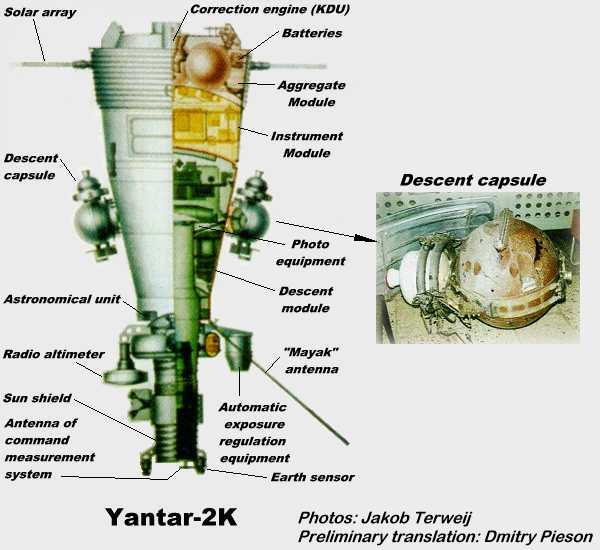
This text is based on the
article by Vladislav Sorokin: Yantar
history in Novosti Kosmonavtiki (Videokosmos) 1997 No 17 p 57. and
1997 No 18/19, translated by Jonathan McDowell.
It is published here with kind permission
from Novosti Kosmonavtiki (Videokosmos)
and from Jonathan McDowell. Igor Lissov of Videokosmos has proof-read Jonathan's
translation and I have inserted Igor's corrections. Longer comments by
Igor are shown in [...]. The
picture above is provided by Jakob Terweij as indicated. The same is true
of the picture below of a Yantar-2K under integration.
A better picture of the little spherical film-return
capsule is also provided by Jakob Terweij. Mr Terweij has also provided
a TsSKB picture of the main
re-entry vehicle after landing and the overall spacecraft
with solar panels.
Sven
Grahn
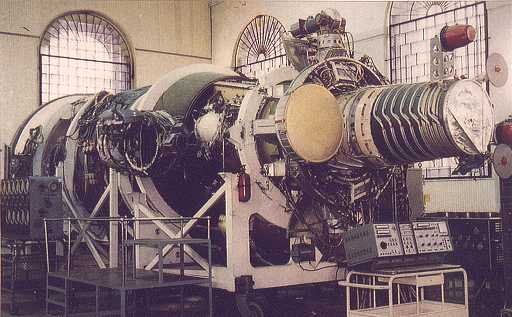
Contents
The first series of reconnaissance
satellites called "fourth generation" in the West was actually designated
Yantar-2K (Yantar means Amber in English) by its designers and had the
product index 11F624. In the Soviet armed forces it had the code name Feniks
(Phoenix). Yantar-2K became the prototype of a series of Soviet reconnaissance
satellites. Design work on this spacecraft started in 1967, it was put
into service in 1978, its last flight took place in 1983 and it was declassified
in 1992. The follow-on spacecraft Yantar-4K (Oktan) was put into service
in 1981 and taken out of service in 1984.
It all began
in 1964
The design of Yantar lasted
a long time - 1964 to 1973. It was nine years from the moment of the start
of the design work at Branch No 1 of OKB-1 on the Yantar series until the
first launch of Yantar-2K. So, the basic work on Yantar began in 1964.
This was an epochal year for Branch No 1 of OKB-1 in Kuibyshev now called
TsSKB:
-
At the start of the year the
Zenit-2 reconnaissance spacecraft (Product number 11F61) launched by the
launch vehicle 11A92 was taken into service bythe Soviet Army.
-
At the end of 1963 (Nov 16)
the first high resolution reconnaissance flight tests were begun.
-
In 1964 all work on optical
reconnaissance satellites was transferred from OKB-1 in Moscow to Branch
No 1 (Kuibyshev branch, renamed TsSKB in 1974). This organisation held
a monopoly on optical observation satellites for many years.
At that time there were two
possible paths for the development of domestic reconnaissance satellites,
either modernizing systems based on Zenit-2 and Zenit-4 by concentrating
on the payload apparatus, or make a new design of spacecraft with new possibilities.
In Branch No 1 both paths were taken. In 1964 the Kuibyshev branch began
draft work on modernization of the Zenit class of spacecraft. Two new systems
were developed:
-
An area survey reconnaissance
model of Zenit-2 called 11F690 Zenit-2M (taken into service in 1970 under
the code name Gektor). The special reconnaissance system Ftor-2 was replaced
by the more capable system Ftor-2R3 (Ftor = "Fluorine")
-
A high-resolution model of Zenit-4
called 11F691 Zenit-4M (put into service
in 1970 under the code name Rotor) with
photo-apparatus Ftor-6, which replaced the Ftor-4 in Zenit-4.
Yantar's roots in the
Soyuz system
In 1964 the Kuibyshev Branch
began work on plans for a piloted reconnaissance spacecraft designated
Soyuz-R (7K-R). Also in 1964 concept definition studies for a new unpiloted
space reconnaissance system began - the Yantar concept. Initially, design
ideas for the new unpiloted craft were taken from Soyuz-R. Two Yantar models
were foreseen: 11F622 Yantar-1 for area survey and 11F623 Yantar-2 for
high resolution imaging. Studies were made of the possibitiy of putting
small return capsules for film on the craft. The design of these capsules
was to be tested on Soyuz-R.
But work on the Yantar concept
went slowly because Branch No 1 was very busy with projects for piloted
craft. The first of these was the piloted reconnaissance spacecraft Soyuz-R
(7K-R, 11F71). The other was the transport ship 11F72 7K-TK for re-supply
of Chelomei's space station Almaz. In 1966-67 design work was also performed
on the military research spaceship Zvezda (7K-VI, 11F73). None of these
projects reached the flight test stage.
However, work on the Yantar
concept did not stand still during these years. Branch No. 1 developed
a project for a high resolution system called Yantar-2K (11F624). Over
time this project became the main Yantar concept. The Yantar-2K, although
it preserved the Soyuz components, at first glance looked very little like
its prototype. The SA was changed from a sphere shape to a cone shape.
Yantar-2K was considered by the space direction of the USSR and on 21 July
1967 the Central Committee of the Communist Party and the Council of Ministers
of the Soviet Union decided on 11F624 in decree no. 715-240. [Igor Lissov
comments: In my records I counted at least five mentions of decrees issued
on 21 Jul 1967. I suspect that Decree 715-240 was in fact an all-embracing
act dealing with all missile and space weapons systems for several years
to come.]
First flight was planned
for 1969. On 24 July 1967, minister of MOM (MOM = Ministry of Common Machine-building)
S A Afanas'ev issued directive no 220 that authorized the planning of the
work on Yantar-2K at Branch No 1 of TsKBEM. On 19 December of same year
Commission of Presidium of Soviet Ministers on military industry issues
,VPK, made decision on work on the satellite. Actually the decision covered
"design of complexes Yantar-2K, Zenit-4M and Zenit-4MT" [Igor
Lissov comments: No, it was Minister Afanasyev's order #4ss issued 6 Jan
1968 dealing with the three complexes.]
During the third and fourth
quarters of 1967 the Kuibyshev Branch worked on the pre-project phase of
Yantar-2K and this work was completed in the second quarter of 1968. After
this the "pre-project phase" of Yantar-2K began. Flight testing of Yantar-2K
was planned for 1970
In January 1968 an order
from the MOM to Branch No 1 ended work on the military research spaceship
7K-VI. However, the experience obtained during the 7K-VI work proved to
be very useful in the Yantar-2K design.
Other
elements in the early Yantar concept
In addition to the Yantar-2K
the Kuibyshev branch had worked on a survey reconnaissance project, earlier
named 11F622 Yantar-1. In 1968 this scheme was worked on in draft form
under the designation 11F630 Yantar-1KF to be launched on a 11A511M rocket.
However, the high-resolution Yantar-2K became the main priority. The Yantar
concept in 1969 contained the following elements:
-
High and very high resolution
systems designated Yantar-4K, 6K, 8K
-
Survey reconnaissance and cartographic
systems designated Y-1KF, Y-3KF and Y-5KF
-
Operational observation system
Malakhit ("Malachite") with radio transfer of data.
So, in addition to the basic
Yantar-2K (11F624) design Branch No 1 was also working on the super high
resolution system Yantar-6K (11F650), the operational high resolution system
Yantar-6KS (11F661) and the survey reconnaissance systems Yantar-1KF(11F630)
and Yantar-3KF (11F649). However, apart from Yantar-2K, not one of the
projects from this late 60's period was realized. Also the modernization
11F642 Yantar-2K-M was not done. After the successful draft project Yantar-2K
in 1969, Branch No 1 worked on technical tasks on construction and elements
of on board systems, instruments, antennae, and other elements of the craft.
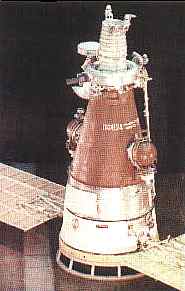 Design
philosophy of Yantar-2K
Design
philosophy of Yantar-2K
The Kozlov book gives an idea
of the design philosophy of Yantar-2K.
"Further search for mass
margin lead to merging the construction of the photostructure and the spacecraft.
The camera system needed to be mounted inside the SA (Spuskayemyy Apparat
= Descent vehicle) so that it could be returned to Earth with the goal
of reusing it. The base part of the SA, in the shape of a partial sphere,
held the film cassette, while the conical front part of the SA acted as
the photoapparatus body. This made it possible to increase the size of
the photo apparatus and substantially increase of the focal length. This
permitted raising the orbital height and allowed a vertical orientation
of the spacecraft. One of the essential deficiencies of the photographic
reconnaissance spacecraft was the delay in the delivery of images to the
data consumers. For the Zenit system the time between taking the image
and returning film to Earth was equal to the active life of the spacecraft.
Very often the photo targets represent "dynamic processes," so in order
to partially remedy this shortcoming, the spacecraft would carry return
capsules - miniature SAs - that could return part of the film to Earth..."
Main
characteristics of the Yantar-2K
The Yantar-2K(11F624 ) satellite
was divided into three modules: the equipment module (AO - Agregatnyy Otsek),
instrument module (PO - Pribornnyy Otsek) and the special apparatus module
(OSA - otsek spetsial'noy apparatury). OSA was recoverable, returning to
Earth the Zhemchug-4 ("Pearl") camera and the onboard computer Salyut-3M,
which were reusable. On opposite sides of the OSA there were two SpK (Spuskayemaya
Kapsula=descent capsules) for returning film to Earth before the end of
the main mission. On top of the OSA was a sunshade for the Zhemchug-4 apparatus.
Before landing the optical system retracted from the shade into the OSA.
All modules of Yantar-2K were in the form of a truncated cone with a half-angle
of 12 degrees, which made the satellite slightly similar externally to
the US Gemini. Maximum diameter of Yantar-2K was 2.7m, with a height of
6.3m. Mass of 11F624 was 6.6 tonnes. The planned lifetime was 30 days.
The equipment
module - AO
The AO contained the engine
installation (kompleksnaya DU, KDU), the BR-91Ts-1 telemetry system, the
11M243 solar array actuators, and the batteries. Outside the AO were two
four-panel orientable solar panels, the AO-Ya antenna of the command-program-trajectory
radiosystem Grafit-Ya ("Graphite"), and on the side wall of the module,
thermal radiators. The KDU of Yantar-2K used the correction-braking engine
11D430 (KTD), a system of low thrust liquid control engines, fuel tanks,
a pressurization system with spherical pressure bottles,..., equipment
for KTD gimballing....
The fuel of the KTD was UDMH
and the oxidizer was N2O4. Oxidizer mass was 195-585
kg and the fuel mass was 105-315 kg. Propellant feeding was performed by
the "blow-down" (pressure-feed) method by using 3.65 kg of helium in spherical
pressure bottles at 3.5-5 MPa. Dry mass of the whole KDU was 375 kg. Total
impulse with all engine installations was 2060 kNs. The KTD had thrust
at range from 2.7 to 3.3 kN (mean 2.943 kN) with a specific impulse of
3015 Ns/kg. The chamber pressure was 0.9 MPa. During a 30-day flight it
could perform up to 50 burns. Control rocket engines (URD) were in four
blocks. In the first collector URD-1 two 11D431 in each block. This small
liquid engine had a thrust of 5.88N, figure of ignition (?)150000, total
burn time 10000 seconds. In the second collector (URD-II) were two variants
of the MZhRD liquid engine type. Thus, in each of four blocks was one 11D446
and one 11D428. The thrust was 52 Newtons, figure of ignition 40000 and
total burn time 4000 s. There was one 11D428 in each of the URD-II blocks.
The 11D428 had a thrust 110 Newtons, figure of ignition 40000 and total
burn time 2000 seconds.
The
instrument module - PO
The pribornyy otsek contained
units of the Kondor movement control system [essentially, attitude control],
apparatus for encoding data, thermal control system, commutator block and
electricity supply system, telemetry system BR-91Ts-1, information handling
system, electronic equipment and Kvadrat ("Square") power gyroscope system
[Some sort of gyrodyne? Sven Grahn's comment]. Outside the module was also
covered with thermal radiator panels.
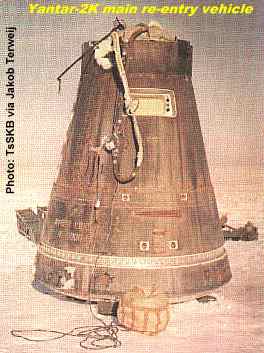 The
landing capsule and camera system module - OSA
The
landing capsule and camera system module - OSA
In the OSA was the photographic
system Zhemchug-4 with main cassettes with film, electronics blocks for
this photo complex, and system of getting film to the landing capsules,
the Kondor control system, the Kalina synchronization unit, the program-timing
unit, the onboard computer (BTsVM) Salyut-3M, and elements of the thermal
control system. The OSA descent and landing system had its own steering
system for the module in atmosphere with gyros giving angular velocity,
a liquid engine for orientation during landing, radioaltimeter, parachute
system and soft landing engine. The spherical base of the OSA had a heat
shield. The OSA steering system had 8 engines of the 11D445 type in 4 blocks.
Each engine had thrust from 65 to 120 Newtons, could fire 10000 times for
total working time of 900 seconds. Fuel was N2O4
and UDMH, like the KDU. The pressurisation system used N2 in
spherical bottles at a pressure of 35.0 MPa. Soft landing engines had one
solid-fuel four-nozzle engine 11D863 with 90 to 100 kN thrust. Impulse
was 25 kNs, chamber pressure 17 MPa, engine mass 35 kg, length 0.64m, diameter
0.28m. This engine was used in the same way as on 3KV and 3KD Voskhod.
Above OSA was the Zhemchug-4 photo sunshade. The sunshade had a movable
cover. On the shade was an antenna of the Grafit-Ya system and an infrared
horizon sensor. On the upper side of the OSA was toroidal module with radiosystem
Granit-Ya, RVV (radioaltimeter-vertical) and optical unit AVU (astrovisir
installation). The latter two units were for receipt of survey information
for ... photos. ... Also on the upper side of OSA was the antenna for VHF-communications
Mayak. ...
The Yantar-2K had a high
resolution Zhemchug-4 camera system (designed at PO Krasnogorskiy Zavod
of the Ministry of Defense Industry) equipped with high the Kondor precision
attitude control device. Initially organized in a horizontally, the optical
system Zhemchug-4 was earlier installed on the Zenit series (where optical
axis was perpendicular to the spacecraft longitudinal axis and the flight
vector), as well as vertically (optical axis on the longitudinal axis of
the ship and perpendicular to the flight vector).
[Igor
Lissov comments: Well, a clarification. Zenit had the horizontal design,
with optical axis perpendicular to the velocity vector and spacecraft axis.
There were two design versions of Yantar - with horizontal and vertical
spacecraft axis. In each case, Zhemchug-4 optical axis would be vertical.
Zhemchug-4 was never used on Zenit.]
The
small landing capsules - SpK
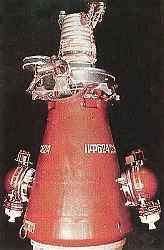 The
two spherical SpK (Spuskayemaya Kapsula, descent capules) were mounted
on opposite sides of the OSA. Inside the capsules were thermal control
systems, telemetry systems, avionics, a VHF beacon, film containers, parachute
systems and a program timer. Outside was the pyrothechnical system for
separation from OSA, the solid fuel braking engine, and the system for
spinning up the capsule. The solid fuel braking engine 11D864 had a thrust
from 34 to 5.9 kN. The impulse was 79 kNs, chamber pressure 8 MPa. Mass
of the motor was 52 kg, length 0.45m, diameter 0.38m. Around the solid
fuel rocket motor the gas reaction engine 8005D-0 was used for stabilizing
the capsule after braking and for angular velocity control. Work on the
SpK began in 1968 at Kuibyshev branch. At that time work was also performed
within Chelomei's OKB-52 on the Block-K (11F76), a special capsule to take
film to Earth from the "Agat" photo complex on the Almaz space station.
The
two spherical SpK (Spuskayemaya Kapsula, descent capules) were mounted
on opposite sides of the OSA. Inside the capsules were thermal control
systems, telemetry systems, avionics, a VHF beacon, film containers, parachute
systems and a program timer. Outside was the pyrothechnical system for
separation from OSA, the solid fuel braking engine, and the system for
spinning up the capsule. The solid fuel braking engine 11D864 had a thrust
from 34 to 5.9 kN. The impulse was 79 kNs, chamber pressure 8 MPa. Mass
of the motor was 52 kg, length 0.45m, diameter 0.38m. Around the solid
fuel rocket motor the gas reaction engine 8005D-0 was used for stabilizing
the capsule after braking and for angular velocity control. Work on the
SpK began in 1968 at Kuibyshev branch. At that time work was also performed
within Chelomei's OKB-52 on the Block-K (11F76), a special capsule to take
film to Earth from the "Agat" photo complex on the Almaz space station.
Launch
vehicle for Yantar-2K, the Soyuz-U
During 1968 Branch No 1 began
preliminary design work on the launch vehicle 11A511M Soyuz-M to be used
for Yantar-2K both at Baikonur and Plesetsk . Earlier this launcher was
planned for 7K-VI. Now it was adapted for a new cargo, but the 11A511M
was never used for Yantar-2K. Instead it was used from 1971 to 1976 to
orbit the topographic satellite Zenit-4MT (11F629, code-named Orion after
put into Soviet Army service in 1976). In 1969 a launch vehicle for new
satellites was discussed and work began on a unified rocket 11A511U (Soyuz-U).
This launcher was developed for Yantar-2K, the manned 7K-T Soyuz, and other
craft from Kuibyshev branch of TsKBEM and other organizations. However
decision on 11A511U to replace 11A57, 11A511 and 11A511M was not made until
5 Jan 1973. Flight testing of 11A511U began in May 1973. First cargo was
the Zenit-4MK (in 1973 only two such flights on 18 May and 21 Sep) and
12KS Bion No. 1 (31 Oct 1973).In 1970, the 11S516 fairing for Yantar-2K/11A511U
was designed.
Flight tests 1974-77
Despite the fact that delays
in the Soyuz-U development caused the planned first launch of Yantar-2K
to be put off until 1973, work continued on the Salyut-3M computer, KPTRL
Granit-Ya programmer, synchronization unit with BSU 'Kalina', telecontrol
unit BR-91-Ts-1. Also Branch No. 1 developed the new main control system
device Kondor. However all this work went slowly. Because of this the Kondor
control system in flight model 1 and 2 of Yantar-2K was replaced by the
Sokol control engine used on the Zenit series. Also, the SpK was also not
ready, so it was decided the first few Yantars would be launched without
capsules. All these problems delayed the flight testing of Yantar-2K. On
3 July 1973 the first flight was set for September 1973, but in September
the first flight test was put off to 15 Jan 1974. In spite of all these
problems the first flight model of Y2K was completed at the Progress plant
in Kuibyshev and sent to Plesetsk.
Testing
of the small capsules on Gektor spacecraft
Tests were done on the separation
systems of the satellite in parallell both on Earth and in space. In 18
Oct 1972 and 22 Mar 1973 at Plesetsk were launched Zenit-2M (11F690 Gektor)
officially named Kosmos-525 and 552. Autonomous satellites of the Nauka
series 16KS No 161 (or 1L) and 162 (or 2L) were put on Gektor. These autonomous
satellites, like almost all the Nauka containers, completed their flight
still attached to the main spacecraft and only after the end of the flight
program, on the day of the Gektor's deorbiting, were they separated. Autonomous
satellite 16KS tested some special systems of Yantar-2K. Testing of elements
of the Kondor control system was performed. Test work of astro-visir and
radioaltimeter was done on the autonomous satellite 17KS Nauka. One such
was M15000-171 or 1L launched on 14 Mar 1974 with a Gektor, Kosmos-635.
In 1974 began the flight testing of the SpK for Yantar-2K. Capsules called
Functional-Experimental installation FEU-170, also went into orbit with
Gektor. The capsule with its separation system was mounted on top of the
Gektor SA and was shot off at time of flight of the satellite. Transfer
of film to capsule from the main ship was obviously not done. The first
time the SpK was sent into orbit was on 3 Oct 1973 aboard Kosmos 596, but
the test was failure. FEU-170 No. 1L had an electrical short circuit. This
led to a failure to separate the shell of the capsule on descent in atmosphere,
so parachute did not deploy and capsule smashed on impact. The first successful
flight of a modified SpK, FEU-170-13 No. 1702 (or 2L) was on Kosmos-629,
launched on 24 Jan 1974. The next test was a failure, 30 Aug 1974. At 338
seconds into the flight the third stage of the 11A57 rocket failed. Gektor
and capsule FEU-170 No 3L were destroyed by command destruct system. Two
following tests were successful on K-692 (FEU-170 No 4L, 1 Nov 1974) and
K-769 (FEU-170-13 No 5L, 23 Sep 1975).
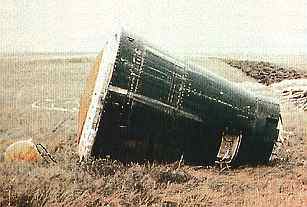 First
test flight
First
test flight
During the flight tests of the
SpK on Gektor the flight testing of the 11F624 Yantar-2K ship itself, without
SpK was begun. First launch was 23 May 1974. But there was a problem in
the separation of the second and third stages of the 11A511U launch vehicle.
At the same time contact was lost with the spacecraft. This led to automatic
destruction of the OSA, so Yantar-2K No. 1 was destroyed. Between the first
and second tests of Yantar-2K there was a notable event in the history
of the Kuibyshev firm. On 30 July 1974 the Branch No 1 of TsKBEM became
the independent orgnaisation TsSKB (now known in the West as the Central
Specialised Design Bureau of Samara). Chief designer remained D I Kozlov.
Also Kozlov was offered the post of chief of TsKBEM instead of Mishin,
but he remained at Kuibyshev.
Second test flight
After rework of launch vehicle
and a failure review, the second launch 11F624 Yantar-2K took place on
13 Dec 1974 as Kosmos 697. This time the test was successful. The flight
program did not foresee a flight duration of 30 days since the craft still
did not not have all subsystems. After 12 days, on 25 December 1974, the
SA of Yantar succesfully landed with film.
Third test flight
The following test, Yantar-2K
No 3, took place on 5 September 1975 (Kosmos 758). This had the first Kondor
attitude control system. This system experienced problems and suffered
a failure on the second day of flight, so on 6 September 1975 the Yantar-2K
destruct system system fired.
Fourth test flight
In 1976 Yantar-2K failures continued.
Yantar-2K No 4 was the first to have two SpK minuature landing capsules.
This was the first flight of a completely equipped satellite and it was
launched as Kosmos-805 on 20 February 1976. The flight program was successful
and after 20 days in orbit, on 11 March, the SA returned. Both SpK separated
from the Yantar in the course of the flight, but did not work correctly.
The parachutes of the first did not deploy and the capsule smashed into
the ground. On the second, incorrect work of compensator gear caused failure
of solid motor 11D864 and the capsule did not deorbit on time.
[Note from Jonathan McDowell:
apparently not tracked; 1976-18C seems to be related to launch vehicle,
re-entered T+2d, there is no SATCAT candidate for the SpK].
Fifth test flight
Spacecraft No 5 was launched
22 July 1976 as Kosmos-844. After separation from the third stage and orbit
insertion, the system of deployment of the second solar battery failed.
On 25 July the satellite was destroyed on command from the Earth.
Sixth
test flight - a total success!
However failures did not stop
the TsSKB. The next year (1977) was triumphant for Yantar-2K. The launch
on 26 April 1977 of Yantar-2K No 6 as Kosmos-905 was a compete success.
Two SpK separated during flight and returned film to Earth. The flight
lasted the full 30 days and SA of Yantar landed in the planned area.
The State Commision decided
that the flight test phase over and designated No 7 as an acceptance flight.
This flight was succesful on 6 September- 6 October 1977 as Kosmos-949.
On 1 November 1977 the state commission accepted 11F624 with a recommendation
that it be taken into service in Soviet Army.
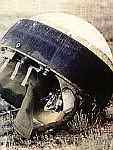 In
military service (1978-1983)
In
military service (1978-1983)
The decree of the Central Committee
of the Communist Party and the Council of Ministers of the Soviet Union
dated 22 May 1978 No. 396-128 took the Yantar-2K system into service in
the Soviet Army. To implement this decree the Ministry of Defense of the
USSR issued directive No. 0065 1978 "on taking into service complex Yantar-2K".
The military gave the system the code name Feniks.
Yantar-2K satellites were
launched on 11A511U rockets both from Plesetsk (from 23 May 1974) and Baikonur
(20 Jan 1981). Operational altitudes of these craft were minimum 170-180
km, max 330-360 km. ) (there were, of course, deviations because, most
likely, of insertion inaccuracies or of specific survey demands). The first
two launched from Plesetsk and one in 1977 used 62.8 deg, the rest were
at 67.1 to 67.2 deg. Launchs from Baikonur initially used 64.9 deg, but
later launches in 1981-83 used 70.4 degrees. Some western analysts saw
this as an indication of an interest in the Falkland Islands, with the
19 December 1981 launch of Kosmos-1330 and the 30 January 1982 launch of
Kosmos-1336, both at 70.4 degrees which they thought were for observation
in the region of the British-Argentine conflict. However, the last of these
craft landed 26 Feb 1982, while blockade and military intervention in Falklands
flared up in April-June 1982.
Lifetime of Yantar-2K was
30 days. Deviations from this were due to technical troubles. The SpK separated
from the Yantar-2K mainly on the 10th and 18th days of flight. The Kettering
Group announced they observed these. The Yantar-2K systemwas used up to
1983. In all there were 30 launch attempts. The launch vehicle failed twice
(23 May 1974 and 28 Mar 1981). Twice craft were destroyed in orbit because
of technical malfunctions which would not permit the OSA to return (6 Sep
1975 and 25 Jul 1976). Last of the 30 launches was 28 Jun 1983.
Yantar-4K1,
the successor
The successful testing of Yantar-2K
in 1977 led to further work at TsSKB. In May 1977 there was a meeting of
Council of Chief Designers at TsSKB to decide about further dvelopment
paths on the basis of the Yantar-2K design. First of the new craft to be
done was Yantar-4K1, with index 11F693. It was distinguished from Yantar-2K
by its longer flight duration, 45 days instead of 30 days. Also it was
planned to have an improved photographic complex. In Apr1977 the draft
project of 11F693 Yantar-4K1 was done at TsSKB. The PO Krasnogorskiy Zavod
worked on photocomplex Zhemchug-18. The 11F693 Yantar-4K1 spacecraft was
almost a copy of Yantar-2K distinguished only by some service and special
systems. On this satellite there were also two SpK. Mass and geometric
parameters of 11F693 were almost identical to 11F624. It was decided to
use the same 11A511U rocket and 11S516 fairing. In 1978 the modernization
of Yantar-2K to Yantar-4K1 was almost complete. In 1979 the technical documentation,
experimental installations and first flight model were ready.
First launch of Yantar-4K1
No. 1 was made on 27 April 1979 from Plesetsk. Like Yantar-2K, it was put
into a 62.8 deg orbit of with typical Yantar parameters: 174 x 336 km.
The 30 day flight went succesfully and on 27 May the OSA landed. 11F693
No. 2 went the planned duration, from 29 April to 12 June 1980. This flight
was also a success. In connection with this it was decided to make 11F693
No 3 the acceptance flight. This was the first Yantar-4K1 flight from Baikonur,
and it lasted from 30 October to 12 December 1980, also without problem.
The state commission for flight testing recommended that it be taken into
service, and in 1981 it was taken into service under the code name Oktan.
The operational Oktan flights began in 1982 with 11F693 No 5 from 8 June
to 22 July. All launches of the twelve flight models of 11F693 were successful.
There were no rocket failures, no destruct on orbit, and all craft flew
for their planned duration. Oktans were launched both from Plesetsk with
67.1-67.2 deg orbits and from Baikonur with 64.9 deg orbits. One launch
on 26 Apr 1983 was in a more polar orbit at 70.4 deg. Orbital heights were
similar to Yantar-2K.
It was expected since the
1960s, that the Yantars would come to replace the earlier Zenit modifications.
However the high resolution Feniks and Oktan were used in parallel with
high resolution Gerakl (11F692M Zenit-4MKM, launched from 12 Jul 1977 up
to 10 Oct 1980). Zenits were replaced only at the end of the 1980s. And
some modifications of this satellite (Oblik, Resurs F-1 and F-2) continued
in use to later times, admittedly for civilian goals. The last Oktan flight
was 30 November 1983 to 13 January 1984 when a directive was issued "on
removal from service from SA the space complexes Feniks and Oktan". They
were replaced with more capable craft. However, that's another story.
List
of Feniks and Oktan launches
See separate
table.

 Back
to Soviet/Russian reconnaissance satellites
Back
to Soviet/Russian reconnaissance satellites



 Design
philosophy of Yantar-2K
Design
philosophy of Yantar-2K The
landing capsule and camera system module - OSA
The
landing capsule and camera system module - OSA The
two spherical SpK (Spuskayemaya Kapsula, descent capules) were mounted
on opposite sides of the OSA. Inside the capsules were thermal control
systems, telemetry systems, avionics, a VHF beacon, film containers, parachute
systems and a program timer. Outside was the pyrothechnical system for
separation from OSA, the solid fuel braking engine, and the system for
spinning up the capsule. The solid fuel braking engine 11D864 had a thrust
from 34 to 5.9 kN. The impulse was 79 kNs, chamber pressure 8 MPa. Mass
of the motor was 52 kg, length 0.45m, diameter 0.38m. Around the solid
fuel rocket motor the gas reaction engine 8005D-0 was used for stabilizing
the capsule after braking and for angular velocity control. Work on the
SpK began in 1968 at Kuibyshev branch. At that time work was also performed
within Chelomei's OKB-52 on the Block-K (11F76), a special capsule to take
film to Earth from the "Agat" photo complex on the Almaz space station.
The
two spherical SpK (Spuskayemaya Kapsula, descent capules) were mounted
on opposite sides of the OSA. Inside the capsules were thermal control
systems, telemetry systems, avionics, a VHF beacon, film containers, parachute
systems and a program timer. Outside was the pyrothechnical system for
separation from OSA, the solid fuel braking engine, and the system for
spinning up the capsule. The solid fuel braking engine 11D864 had a thrust
from 34 to 5.9 kN. The impulse was 79 kNs, chamber pressure 8 MPa. Mass
of the motor was 52 kg, length 0.45m, diameter 0.38m. Around the solid
fuel rocket motor the gas reaction engine 8005D-0 was used for stabilizing
the capsule after braking and for angular velocity control. Work on the
SpK began in 1968 at Kuibyshev branch. At that time work was also performed
within Chelomei's OKB-52 on the Block-K (11F76), a special capsule to take
film to Earth from the "Agat" photo complex on the Almaz space station.
 First
test flight
First
test flight In
military service (1978-1983)
In
military service (1978-1983)